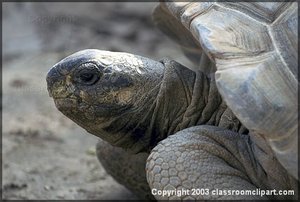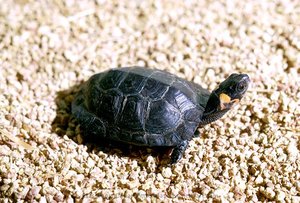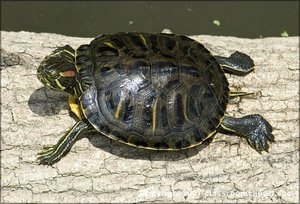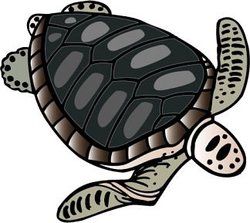Turtle
|
|
| Turtles | ||||||||
|---|---|---|---|---|---|---|---|---|
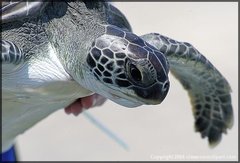 Sea Turtle. Picture provided by Classroom Clip Art (http://classroomclipart.com) | ||||||||
| Scientific classification | ||||||||
| ||||||||
| Families | ||||||||
|
See text |
Turtles are reptiles of the order Testudinata, most of whose body is shielded by a special bony shell developed from their ribs. The term turtle is usually used for the aquatic species, aquatic fresh-water turtles also being referred to as terrapins. The term is also used (esp. North America) to refer to all members of the order, including tortoises, which are predominantly land based. The order of Testudines includes both extant (living) and extinct varieties. About 300 species are alive today. When a turtle is in its egg the temperature determines whether it's male or female: a higher temperature becoming a female, a lower temperature becoming a male.
Sea turtles grow to large sizes and live in the oceans in the temperate and tropical regions of the earth. Pond turtles (or terrapins) are generally of a much smaller size, while land based terrapins (or tortoises) can be as big as the sea turtles. The measured sizes of turtles varies from a few centimetres (forest/jungle species) to up to two meters (the leatherback and the Galapagos tortoises). All turtles have a protective shell around their bodies. The top part of their case is called the carapace, the underside is the plastron, and the two are connected by the bridge. Turtles generally live a long time; some individuals are known to have lived longer than 150 years. The oldest tortoise on record is known to have lived at least 188 years.
The first turtles already existed in the era of the dinosaurs, some 200 million years ago. Turtles are the only surviving branch of the even more ancient clade Anapsida, which includes groups such as the procolophonoids, millerettids and pareiasaurs. All anapsid skulls lack a temporal opening. All other extant amniotes have temporal openings (although in mammals the hole has become the zygoid arch). Most of the anapsids became extinct in the late Permian period, with the exception of the procolophonoids and the precursors of the testudines (turtles).
However, it has recently been suggested that the anapsid condition of the turtle skull may not be a primitive character reflecting anapsid descent, but rather a case of convergent evolution. More recent phylogenetic studies with this in mind have placed turtles firmly within diapsids, slightly closer to Squamata than to Archosauria. All molecular studies have strongly upheld this new phylogeny, though some place turtles closer to Archosauria. Re-analysis of prior phylogenies that affirmed an anapsid ancestry suggests that their inclusion of turtles within Anapsida was due to both the starting assumption that they were anapsid (most prior phylogenies concerned what sort of anapsid they were) and also due to insufficiently broad sampling of fossil and extant taxa for construction of the cladogram. While the issue is far from resolved, most scientists now lean towards a Diapsid origin for turtles.
Even though they spend large amounts of their lives underwater, turtles are air-breathing reptiles, and must surface at regular intervals to refill their lungs with fresh air. They also spend part of their lives on dry land. Sea turtles lay their eggs on dry sandy beaches, and are highly endangered largely as a result of beach development and over hunting.
Aquatic respiration in Australian freshwater turtles is currently being studied. Some species have large cloacal cavities that are lined with many finger-like projections. These projections, called "papillae", have a rich blood supply, and serve to increase the surface area of the cloaca. The turtles can take up dissolved oxygen from the water using these papillae, in much the same way that fish use gills to respire.
| Contents |
Order Testudines - Turtles
Suborder Cryptodira
- Family Chelydridae (Snapping Turtles)
- Superfamily Testudinoidea
- Family Testudinidae (Tortoises)
- Family Bataguridae (Asian River Turtles, Leaf and Roofed Turtles, Asian Box Turtles)
- Family Emydidae (Pond Turtles/Box and Water Turtles)
- Superfamily Trionychoidea
- Family Carettochelyidae (Pignose Turtles)
- Family Trionychidae (Softshell Turtles)
- Superfamily Kinosternoidea
- Family Dermatemydidae (River Turtles)
- Family Kinosternidae (Mud and Musk Turtles)
- Family Platysternidae (Big-headed Turtles)
- Superfamily Chelonioidea
- Family Cheloniidae (Sea Turtles)
- Family Dermochelyidae (Leatherback Turtles)
Suborder Pleurodira
- Family Chelidae (Austro-American Sideneck Turtles)
- Superfamily Pelomedusoidea
- Family Pelomedusidae (Afro-American Sideneck Turtles)
- Family Podocnemididae (Madagascan Big-headed and American Sideneck River Turtles)
See also
- Tortoise - the terrestrial version of the turtles.
Animal Videos
- Animal Videos (http://classroomclipart.com/clipart/Videos/Animals.htm)
- Marine Animal Videos (http://classroomclipart.com/clipart/Videos/Animals/Marine_Animals.htm)
- Mammal Videos (http://classroomclipart.com/clipart/Videos/Animals/Mammals.htm)
- Amphibian and Reptile Videos (http://classroomclipart.com/clipart/Videos/Animals/Amphibians_and_Reptiles.htm)
Clipart and Animal Clipart & Pictures
- Clipart (http://classroomclipart.com/clipart/Clipart.htm)
- Animal Clipart (http://classroomclipart.com/clipart/Clipart/Animals.htm)
- Animal Animated Clipart (http://classroomclipart.com/clipart/Animations/Animals.htm)
- Pictures of Animals (http://classroomclipart.com/clipart/Animals.htm)
- Pictures of Turtles and Tortoises (http://classroomclipart.com/cgi-bin/kids/imageFolio.cgi?direct=Animals/Reptiles/Turtles_and_Tortoises)
- Turtle Clipart (http://classroomclipart.com/cgi-bin/kids/imageFolio.cgi?direct=Clipart/Animals/Reptiles/Turtle_Clipart)

